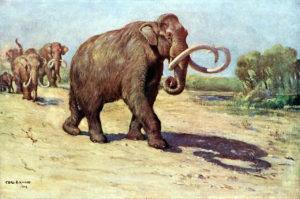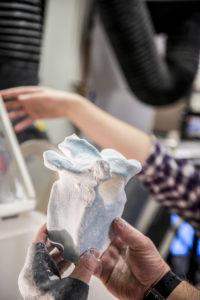Located on the campus of the University of Washington, the Burke Museum of Natural History and Culture is the oldest museum on the West Coast and boasts a collection of 16 million artifacts and fossils. Among its collection are the remains of a 13,000-year-old giant Columbian Mammoth that stands over 13 feet tall at the shoulders. As the museum begins construction on a new building on campus, expected to open in 2019, the staff decided that they wanted to display their Columbian Mammoth skeleton in the new exhibition hall. The only problem is that when the skeleton was discovered near Richland, Washington only about 20% of its bones were found.

Pre-engineering junior Kurt Weiss scans a mammoth skull. [Image: Dennis Wise/University of Washington]
The museum staff reached out to Steven Weidner, an affiliate instructor from UW’s mechanical engineering department, for help. The size and scope of the project was, well, mammoth, and if it was successful it would completely change the way that the Burke’s collection of artifacts are documented, stored, shared with the scientific community and put on public display. A plan was developed that would call for Weidner to create a multi-year 3D printing and 3D scanning project. UW engineering students and instructors would be working closely with museum staff to scan, digitize and ultimately 3D print all of the missing parts of the mammoth skeleton as part of an interdisciplinary class that would merge engineering and paleontology.
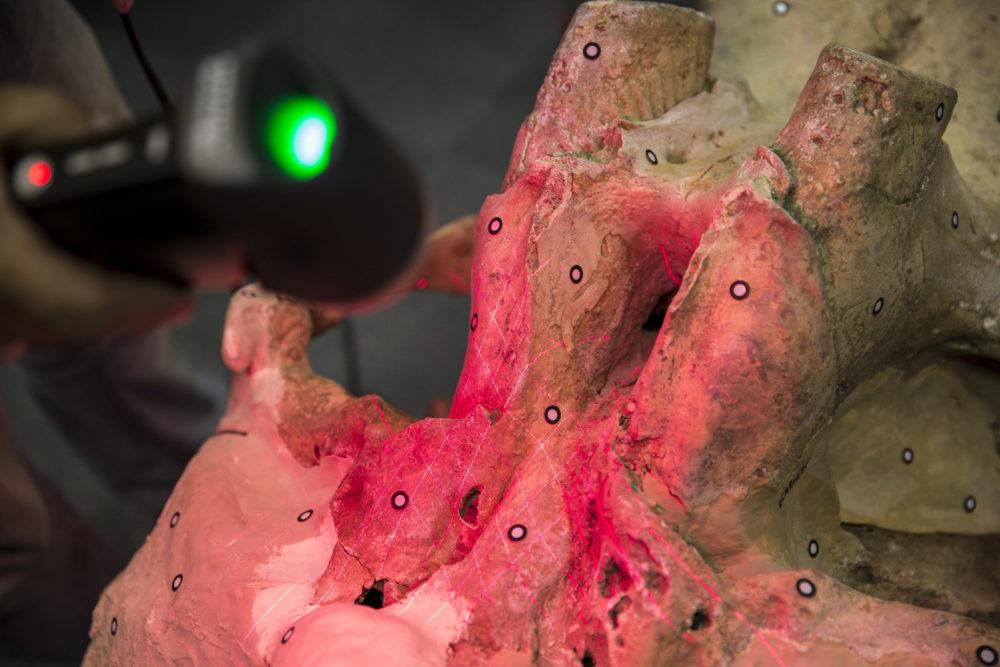
Using a hand-held 3D scanner to scan the mammoth skull. [Image: Dennis Wise/University of Washington]
“This project is where Jurassic Park meets the Star Trek replicator. By printing this mammoth, we’re pushing the boundaries of what’s possible with large-scale 3D printing,” explained Weidner.
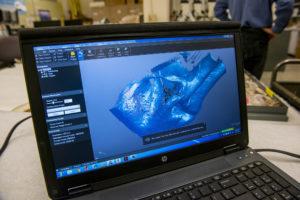
A digital model of the mammoth skull can be turned into a 3D printable model. [Image: Dennis Wise/University of Washington]
In order to recreate the missing bones from the Richland mammoth, the team of students are resorting to some clever and rather resourceful cheats. The Burke’s collection has fossils from several other mammoths available, and they are 3D scanning bones from those and adapting them to their larger and more complete cousin. Additionally, they are also creating mirror-image copies of several of the Richland mammoth bones that do exist in order to fill in some of the holes. In addition to allowing the team to create the missing bones, it turns out that the 3D scanning process is also revealing a lot of valuable data on mammoth anatomy that will be made available online for researchers all over the world to study.
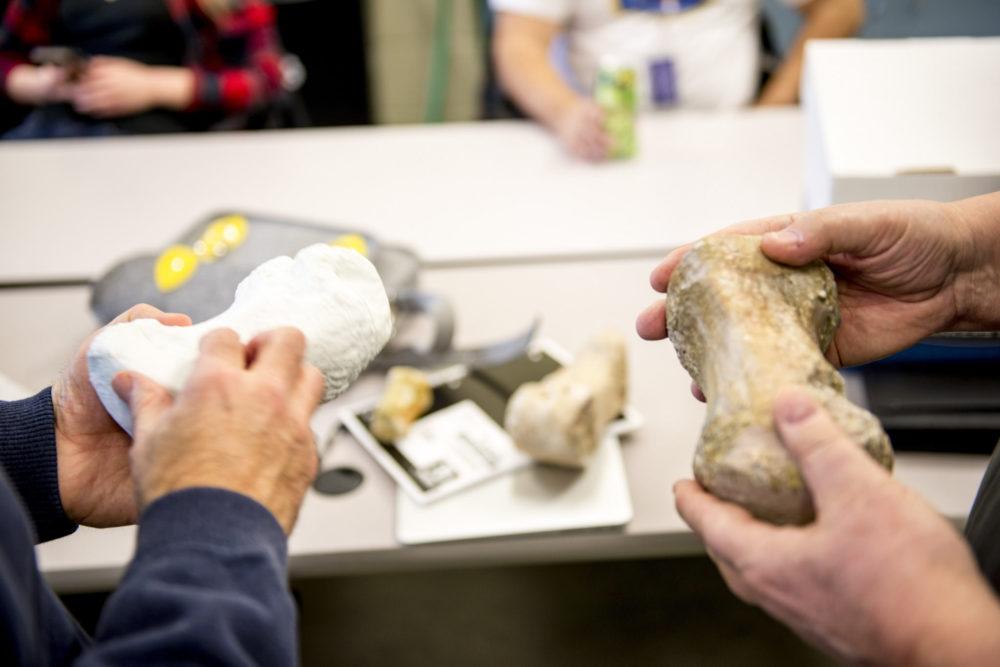
UW students compare a metatarsal (middle toe) bone from the Richland mammoth with its 3D printed replica. [Image: Dennis Wise/University of Washington]
So far the student team has 3D printed several of the smaller 3D scanned bones, like the metatarsals (toes) and the mammoth’s vertebrae using desktop 3D printers. However, the students are still exploring the best ways to produce the bone replicas. Different types of 3D printers are going to produce different final models, each with pros and cons, so part of the ongoing project is working to find the best 3D printers for the job. In fact, the class is working closely with a student-led 3D printing club at the UW College of Engineering called WOOF3D to build a custom, large-scale 3D printer named Big Blue. With a 1.5 cubic meter (4.9 foot) build space, Big Blue is being developed specifically to handle printing larger bones like the skull and the jaw bone.“In every scan and printed item, we aim for perfection. ‘Good enough’ doesn’t cut it in engineering or in scientific research, and so we must ensure our final results are as close to the real thing as possible,” Weidner said.
Because the Richland mammoth project was developed as an interdisciplinary course, each session is being offered by different academic departments. For instance, the Winter 2016 session will be offered by the mechanical engineering department while the Spring 2016 session is being offered by the biology department. Not only does this draw in students from other disciplines, but it is giving those students a much broader educational experience that is expecting them to work with each other to identify problems and difficulties and then find solutions through experimentation with different technologies and methods. It is providing students who may not have ever had access to 3D printing and 3D scanning technology with new skills that they can take with them into the job market after they graduate. It isn’t often that pre-engineering students studying aerospace and aerodynamic design take a class offered by the the biology department.
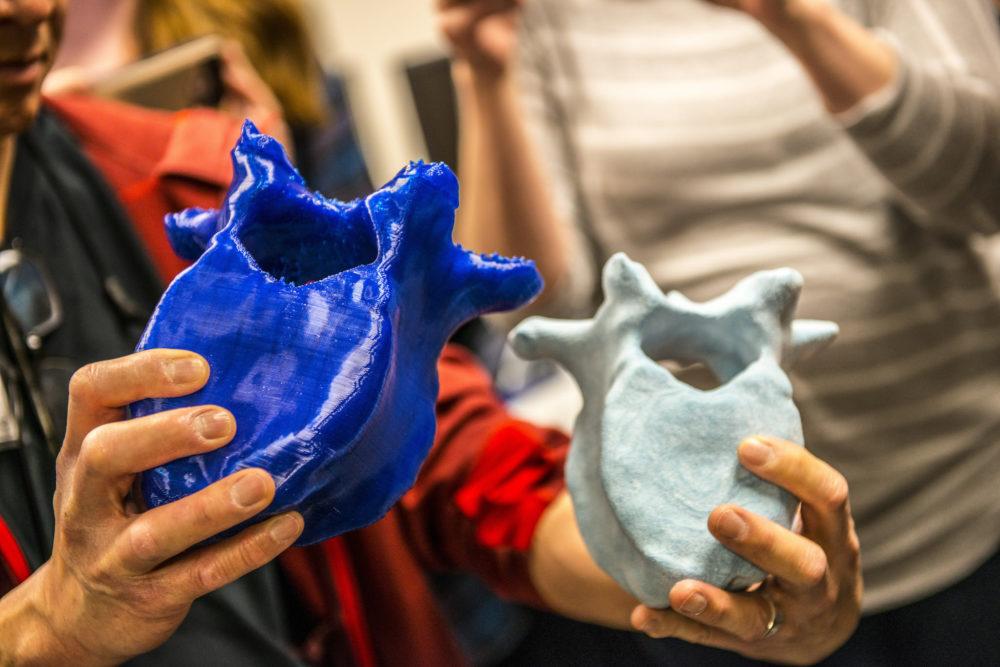
UW students compare 3D printed replicas of a mammoth’s vertebra that were created with two different 3D printing processes. [Image: Dennis Wise/University of Washington]
“An opportunity to work with fossils and cutting-edge scanning and modeling technologies? I signed up for the class immediately. These areas deal heavily with 3D renderings and scaled models testing within wind tunnels. So the experience I’m getting through this class with the wide variety of scanning equipment, modeling programs and printing technologies is helping me develop the knowledge and skills I’ll need down the road,” explained pre-engineering student Kurt Weiss.
So far about 20 students have signed up for the class, and they range from first-year undergraduates to graduate students. Half of them are studying engineering degrees for mechanical engineering, aeronautics and astronautics, and human centered design and engineering, while the rest are studying museology, geology, paleobiology, archeology and even photomedia. Weidner plans to offer the course next year because he is certain that every future stage of the ongoing project will bring new challenges and problems that are excellent educational opportunities for students. What do you think of this ‘mammoth’ 3D printing project? Let’s discuss it further over in the 3D Printed Mammoth Skeleton forum at 3DPB.com.
[Source/Images: University of Washington]
Subscribe to Our Email Newsletter
Stay up-to-date on all the latest news from the 3D printing industry and receive information and offers from third party vendors.
You May Also Like
3D Printing News Briefs, April 13, 2024: Robotics, Orthotics, & Hypersonics
In 3D Printing News Briefs today, we’re focusing first on robotics, as Carnegie Mellon University’s new Robotics Innovation Center will house several community outreach programs, and Ugogo3D is now working...
Rail Giant Alstom Saves $15M with 3D Printing Automation Software 3D Spark
3D Spark has entered into a three-year deal with the rail giant Alstom. Alstom, a transport behemoth with annual revenues of $16 billion, specializes in the manufacture of trains, trams,...
Meltio Expands Global Reach with New Partnerships in the Americas and Europe
Spanish 3D printing manufacturer Meltio has expanded its sales network across the globe. With the addition of three new partners in the United States, Brazil, Argentina, and Italy, Meltio aims...
3D Printing Webinar and Event Roundup: April 7, 2024
Webinars and events in the 3D printing industry are picking back up this week! Sea-Air-Space is coming to Maryland, and SAE International is sponsoring a 3D Systems webinar about 3D...


